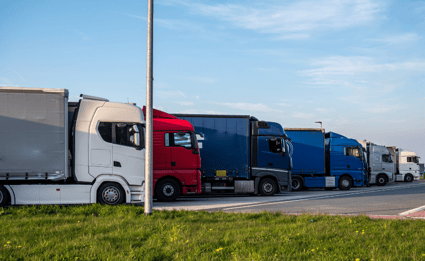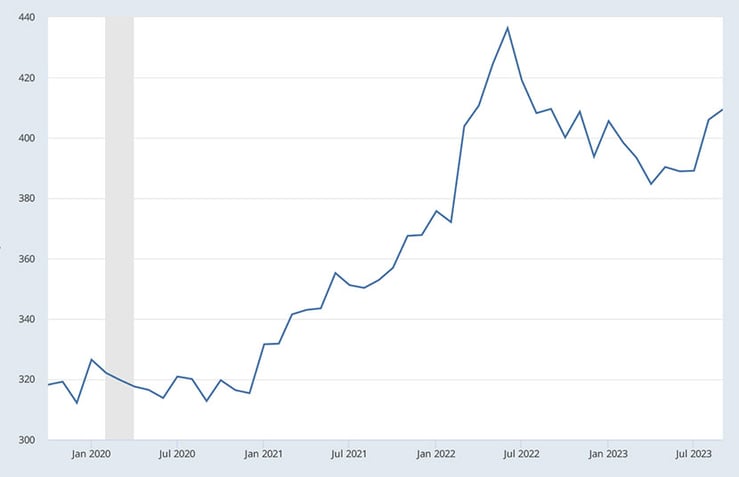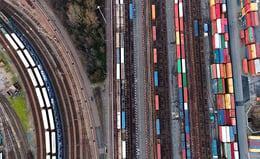How to Lower Transport Costs With High Fuel Prices
Keith LaBotz - December 14, 2023

Reducing shipping costs in an inflationary environment is challenging, and transportation cost optimization is critical to increasing supply chain resilience. What steps can your company take to improve these crucial areas quickly?
Producer Price Index: General Freight Trucking, Long-Distance LTL, Truckload

Source: Federal Reserve
Escalating transportation costs over the past three years highlighted the importance of agile transportation management. The graph above tells a story that will end well for shippers and transportation providers who understand how it goes.
The Story Behind Transportation Costs
The story is simple, and you can see how each chapter changed the graph of transportation prices:
- Chapter 1: Supply Chains Shut Down: Early 2020 lockdowns sent demand and freight volumes plummeting.
- Chapter 2: Supply Chains Restart: As lockdowns were lifted in the spring of 2020, supply chains sputtered back to life, igniting a wildfire of expanding capacity problems, bottlenecks, shortages, and waves of volatility.
- Chapter 3: Demand Surges with Stimulus Spending: From April 2020 to December 2021, nearly 5 trillion USD in government stimulus spending flooded economies, and demand surged. Freight prices skyrocketed as capacity could not meet demand, exacerbating the abovementioned problems.
- Chapter 4: Inflation Surges from Stimulus Spending Between November 2020 and November 2021, the US Consumer Price Index rose 6.8%, beginning historic inflation that pushed transport rates higher.
- Chapter 5: High Fuel Prices: In March 2022 - March 2023, geopolitical developments and policy decisions reduced cheap fuel supplies in some countries, adding rising fuel costs on top of monetary inflation. As demand softened, so did freight rates, and higher operating costs sent more transport providers into bankruptcy and downsizing.
- Chapter 6: Digitized Transportation: A recent report by McKinsey shows shippers and transportation providers are increasing investments in digital transportation solutions to mitigate future uncertainties. While this development is not directly visible in the graph, it creates unprecedented capabilities that will significantly alter transportation.
Building Adaptable Supply Chain Processes
Every company is writing Chapter 7 right now. No one can predict where fuel prices and transport costs are headed, but it doesn’t matter for companies building adaptable supply chain processes. That's the moral of this story, and it's crucial because the unprecedented actions in the first six chapters will cause unprecedented consequences, resulting in big winners and losers.
Transportation is the core of every supply chain, so the outcome for every participant depends on how effectively their digital solutions navigate these future uncertainties. Let’s examine four steps shippers and logistics providers can take to navigate the future to greater success.
1. Improve Equipment Efficiency
- Tractor Aerodynamics: According to the North American Council for Freight Efficiency, over cab and roof extenders and streamlining tractor-trailer gap devices, mirrors, headlamps, bumpers, chassis, and wheel fairings can reduce fuel consumption by 15%.
- Idle Reduction The average truck idles for 1,000 hours a year to power driver compartment heating, cooling, and electronics. Idle-reduction solutions such as onboard diesel and battery units, engine start-stop, and diesel heaters minimize the fuel expense, emission, and noise from idling.
- Fuel Savings Programs: Transport operators that use fuel cards typically reduce diesel costs by up to 5%, and signing long-term agreements with fuel providers stabilizes fluctuating fuel prices.
- Auto Inflate Tire Pressure: Fuel consumption increases roughly 1.0% when for each ten psi a tire is underinflated, and according to the North American Council for Freight Efficiency, 20% of trucks operate with at least one tire underinflated by 20 psi.
Automatic tire inflation systems improve fuel efficiency by 1-2%, carbon emissions, tire life, and driver safety, and avoid fines for improper inflation. Payback typically spans around one year.
- Deploy Telematics: Telematics monitors driver and truck performance, guiding cost reductions drivers can make, such as identifying optimal shift points and reducing speed, acceleration, braking, and idle time.
- Perform Routine Maintenance: Keeping vehicles in peak operating condition is essential for maximizing efficiency, safety, and uptime.
2. Network Optimization
Shipping from the optimal location significantly improves transportation costs, network profitability, agility, performance, risks, and carbon footprint.
Advanced planning technologies like the flexis cloud can analyze a supply chain or transportation network and identify the optimal location for every depot, manufacturing site, and supplier. Scenario-based planning with historical activity, forecasts, and what-if analysis can optimize the network using various transportation strategies:
- On-Shoring: Sourcing goods and materials domestically, where transportation costs at risk are minimized.
- Near-Shoring: Similar to on-shoring, near-shoring involves sourcing from international suppliers on the same continent or offshore. For example, US factories are switching from Asian suppliers to Mexico or Canada, reducing transportation costs.
- Dual Sourcing: Diversifying across multiple suppliers expands options, allowing greater flexibility in responding to unexpected regional disruptions like geopolitical and civil turmoil, restrictive policies, and unfavorable economic conditions.
- Regional Distribution: Diversifying from a single distribution site to multiple regional warehouse locations can reduce delivery costs, transit times, fuel consumption, and carbon emissions.
3. Transportation Optimization
Holistic planning solutions like flexis Transportation and Planning optimize transportation with overall supply chain management functions to increase agility and achieve optimal outcomes. - Transportation Planning and Scheduling: Optimizes shipping plans across the logistics network with changing demand, disruptions, and constraints.
- Order Slotting and Demand Capacity Management: Alters production and transportation schedules as demand, transportation, and production constraints change.
- Inbound Freight Optimization: Adjusts supplier shipping and factory production with changes in demand and delivery schedules.
- Consolidation Combines orders into single shipments and multiple shipments into multi-stop truckloads in coordination with production and distribution commitments.
- Loading Optimization: Fully utilizes cargo space and loads for the most efficient unloading sequence of multi-modal containers and trailers.
4. Optimize Vehicle Routing and Scheduling
Optimized vehicle routing and scheduling (VRS) solutions ensure a delivery fleet operates at peak efficiency by streamlining workflow and decisions, providing resources are utilized most effectively, and maximizing fuel economy. Solutions like flexis VRS dynamically adjust delivery plans as changes are encountered en route.
- Improves on-time pickup and delivery.
- Reduces fuel consumption and greenhouse gas emissions.
- Maximizes productivity by avoiding wait times and traffic congestion.
- Compliance with driver time regulations prevents costly fines.
Conclusion
Companies can prosper regardless of fuel prices if transportation processes adapt as conditions change. The flexis cloud provides a comprehensive suite of transportation optimization solutions that can be quickly implemented to minimize cost and maximize supply chain resilience.
Want to learn more? Find out how flexis can work for you.
LATEST POSTS
- Understand Circular Economy in The Manufacturing Industry
- How Can Industry 4.0 IT Integration Be Achieved Smoothly?
- The Significance of Order Sequencing in Discrete Manufacturing
- How to improve your Supply Chain Management: The Power of Control Towers
- Optimizing Human Resource Scheduling in Manufacturing: A Technological Approach


